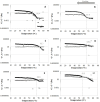Advanced Biomaterial for Dual-Drug Release: A Hydrogel-Microparticle Approach
- PMID: 40944608
- PMCID: PMC12433186
- DOI: 10.1002/bip.70049
Advanced Biomaterial for Dual-Drug Release: A Hydrogel-Microparticle Approach
Abstract
Advanced biomaterials with dual drug delivery represent a promising strategy to enhance therapeutic outcomes in wound treatment. This work aimed to combine antimicrobial and analgesic actions in a single platform, enabling the simultaneous release of both drugs from an advanced dual-drug delivery system based on a combined hydrogel and microparticle approach. The system was composed of alginate microparticles containing the antibiotic gentamicin incorporated into a gellan gum/collagen hydrogel matrix, in which the local anesthetic bupivacaine was directly loaded. The resulting composite was thoroughly characterized in terms of its morphological, physicochemical, mechanical, rheological, and thermal properties, as well as drug release profiles. The incorporation of microparticles significantly influenced the structural and functional behavior of the hydrogel, particularly at higher microparticle concentrations (50% w/v). Notably, the microparticles played a crucial role in maintaining the hydrogel's integrity in the presence of both drugs and enabled their controlled and simultaneous release, with each exhibiting distinct release kinetics. These findings highlight the potential of this hydrogel and microparticle composite as an advanced material for wound dressings, capable of promoting healing while simultaneously providing localized pain relief.
Keywords: biopolymers; controlled release; dual‐drug delivery; hydrogel; microparticles; polysaccharides; wound healing.
© 2025 The Author(s). Biopolymers published by Wiley Periodicals LLC.
Conflict of interest statement
The authors declare no conflicts of interest.
Figures








References
-
- Liu W., Zhai X., Zhao X., et al., “Multifunctional Double‐Layer and Dual Drug‐Loaded Microneedle Patch Promotes Diabetic Wound Healing,” Advanced Healthcare Materials 12 (2023): 2300297. - PubMed
-
- Mostofizadeh M., Ghasemi‐Mobarakeh L., and Zamani M., “Dual Drug Release From Gelatin/PLGA Core–Shell Fibers for Diabetic Neuropathic Wound Healing,” Macromolecular Materials and Engineering 307 (2022): 2100490.
-
- Tada D. B., Singh S., Nagesha D., et al., “Chitosan Film Containing Poly(D,L‐Lactic‐Co‐Glycolic Acid) Nanoparticles: A Platform for Localized Dual‐Drug Release,” Pharmaceutical Research 27 (2010): 1738–1745. - PubMed
MeSH terms
Substances
Grants and funding
LinkOut - more resources
Full Text Sources

